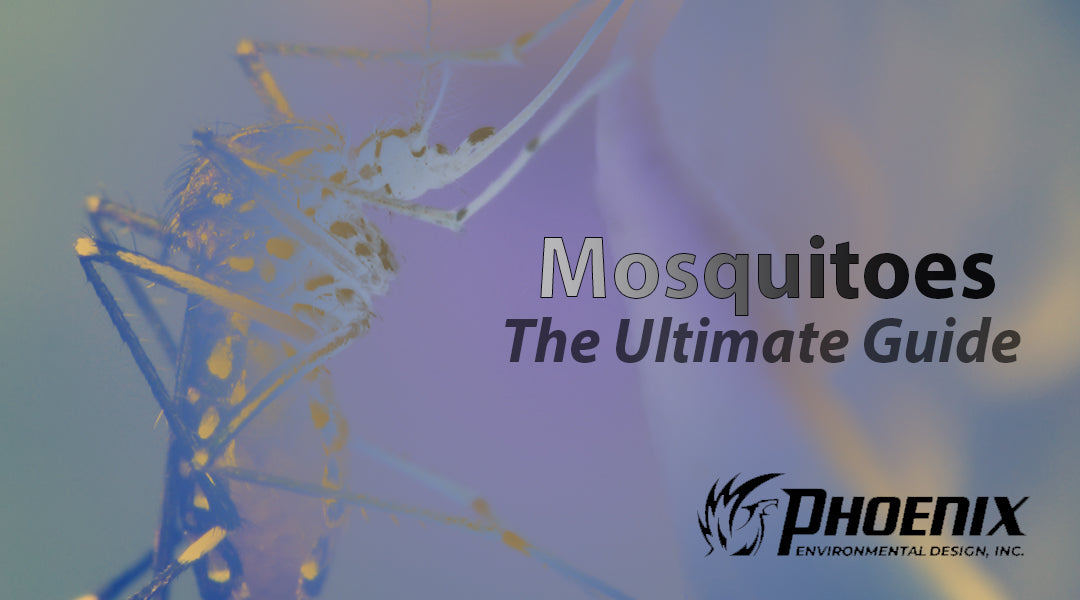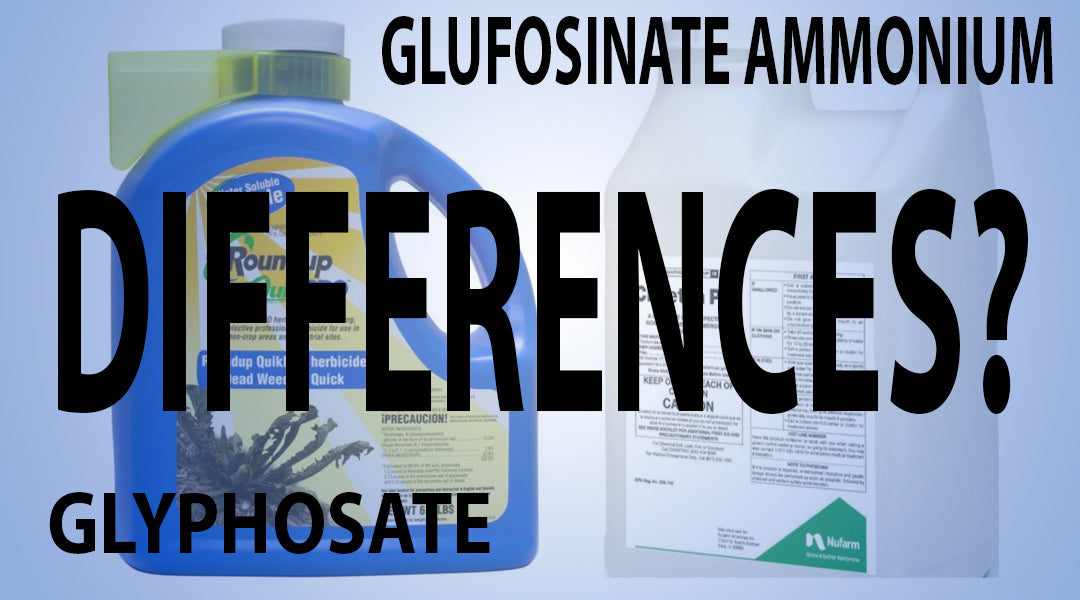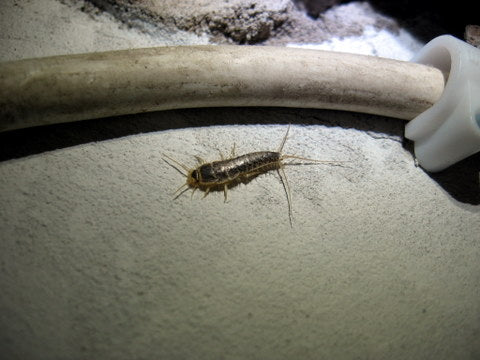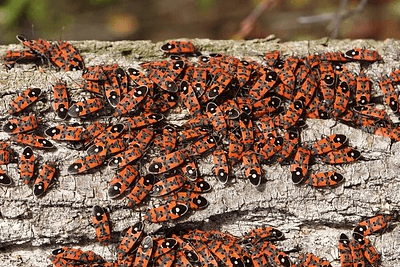
Mosquitoes are more than just a nuisance; they can pose significant health risks by transmitting diseases such as malaria, dengue fever, and Zika virus. As a result, effective mosquito control is crucial for protecting our homes, businesses, and outdoor spaces from these pesky insects. In this comprehensive guide, we'll cover everything you need to know about mosquitoes, including their identification, the problems they cause, and various methods to prevent and control their populations.
Whether you're a professional pest control operator or a DIY enthusiast, this guide is designed to equip you with the knowledge and tools necessary to tackle mosquito infestations and safeguard your property from these unwelcome pests.
Identify Them: Types of Mosquitoes
Mosquitoes are small, flying insects that belong to the family Culicidae. There are over 3,500 species of mosquitoes worldwide, but only a few hundred of these are considered to be of significant public health concern due to their ability to transmit diseases to humans and animals. This article will provide an overview of the different types of mosquitoes, their identifying features, and the significance of their identification for public health and mosquito control efforts.
Anopheles Mosquitoes
Anopheles mosquitoes are the primary vectors of malaria, a disease that affects millions of people worldwide each year. There are over 400 species of Anopheles mosquitoes, but only about 30 to 40 of them are efficient vectors of human malaria. Anopheles mosquitoes can be found on every continent except Antarctica and are most prevalent in tropical and subtropical regions.
Identification
Anopheles mosquitoes have a unique resting posture that distinguishes them from other mosquito genera. When resting, their abdomen is raised at an angle to the surface they are on, while their head and thorax are in line with the surface. Anopheles mosquitoes have a relatively narrow body with long legs and wings. The wings are covered in scales, which form distinct patterns that can be used to identify different species. The palps, which are sensory appendages near the mouthparts, are also long and slender in Anopheles mosquitoes.
Significance
Identifying Anopheles mosquitoes is crucial for malaria control efforts, as these mosquitoes are the primary vectors of the disease. Targeted control measures, such as the use of insecticide-treated bed nets and indoor residual spraying, can be most effective when focused on the specific Anopheles species responsible for malaria transmission in a given area.
Aedes Mosquitoes
Aedes mosquitoes are known for their ability to transmit several viral diseases, including dengue fever, Zika virus, chikungunya, and yellow fever. There are approximately 950 species of Aedes mosquitoes, with Aedes aegypti and Aedes albopictus being the most significant in terms of public health. Aedes mosquitoes are most commonly found in tropical and subtropical regions, but some species can also be found in temperate climates.
Identification
Aedes mosquitoes have a distinctive black and white coloration on their body and legs, which can help to distinguish them from other mosquito genera. The most notable identifying feature of Aedes aegypti is the presence of a lyre-shaped pattern of white scales on the dorsal side of the thorax. Aedes albopictus, also known as the Asian tiger mosquito, has a single white stripe running down the center of its thorax. Both species have banded legs, which also helps with identification. Aedes mosquitoes typically have a more robust body shape than Anopheles mosquitoes, and their wings are generally shorter and broader.
Significance
Accurate identification of Aedes mosquitoes is essential for the control and prevention of the diseases they transmit. Efforts to reduce the breeding sites of Aedes mosquitoes, such as eliminating standing water and implementing larval control measures, can help to reduce the risk of disease transmission in areas where these mosquitoes are prevalent.
Culex Mosquitoes
Culex mosquitoes are responsible for transmitting several diseases, including West Nile virus, St. Louis encephalitis, and Japanese encephalitis. There are over 1,200 species of Culex mosquitoes found worldwide, with Culex pipiens and Culex quinquefasciatus being among the most significant in terms of public health. Culex mosquitoes are most commonly found in temperate and tropical regions.
Identification
Culex mosquitoes have a relatively stocky body compared to Anopheles and Aedes mosquitoes. When resting, their body is parallel to the surface they are on, unlike the angled resting posture of Anopheles mosquitoes. The wings of Culex mosquitoes are usually covered in scales, but the patterns are less distinct than those of Anopheles and Aedes mosquitoes. The palps of Culex mosquitoes are short and club-shaped, differing from the long, slender palps of Anopheles mosquitoes.
One of the key identifying features of Culex mosquitoes is the presence of numerous setae, or hair-like structures, on their body and legs. The abundance of setae can vary between species, and these differences can be used to help identify different Culex species.
Significance
Identifying Culex mosquitoes is important for the control and prevention of diseases such as West Nile virus and various types of encephalitis. Targeted control measures, including the reduction of breeding sites and the use of larvicides and adulticides, can be most effective when focused on the specific Culex species responsible for disease transmission in a given area.
Mansonia Mosquitoes
Mansonia mosquitoes are responsible for the transmission of several diseases, including Rift Valley fever and some forms of filariasis. There are about 20 species of Mansonia mosquitoes, with Mansonia uniformis and Mansonia titillans being the most significant in terms of public health. These mosquitoes are found in tropical regions, particularly in areas with aquatic vegetation.
Identification
Mansonia mosquitoes are medium-sized, with a relatively robust body shape. Their wings are covered in scales, which form distinctive patterns that can be used to identify different species. One key identifying feature of Mansonia mosquitoes is the presence of an elongated siphon, or breathing tube, at the tip of their abdomen. This siphon allows them to obtain air from underwater plants while their body remains submerged, which is a unique adaptation among mosquitoes.
Significance
Identifying Mansonia mosquitoes is important for the control and prevention of diseases such as Rift Valley fever and filariasis. Because these mosquitoes breed in areas with aquatic vegetation, control measures should focus on the management of these habitats, including the reduction of vegetation and the use of biological control agents, such as larvivorous fish, to reduce larval populations.
There are thousands of mosquito species worldwide, with only a small percentage being significant vectors of human and animal diseases. Accurate identification of mosquito species is crucial for effective mosquito control and disease prevention efforts. Anopheles, Aedes, Culex, and Mansonia mosquitoes are among the most important in terms of public health, and each genus has distinct identifying features that can be used to differentiate them from one another.
By understanding the unique characteristics of these mosquito genera, public health professionals and pest control experts can implement targeted control measures to reduce the risk of disease transmission and improve overall public health.
Types of Mosquitoes Diseases
Mosquitoes are more than just annoying pests that leave itchy bites; they are a significant public health threat. As an expert pest control professional, I can attest to the numerous problems that mosquitoes create for humans and animals alike. In this article, we will delve into why mosquitoes are such a problem and the reasons behind their notoriety as one of the most dangerous pests on Earth.
The Global Impact of Mosquitoes
Mosquitoes are responsible for the transmission of several deadly diseases, making them the deadliest creatures on the planet. They kill more people annually than any other animal, including sharks, snakes, and even humans. Mosquito-borne diseases such as malaria, dengue, Zika, West Nile virus, and various forms of encephalitis are responsible for hundreds of thousands of deaths and millions of illnesses each year.
Malaria: A Deadly Disease
Malaria is a mosquito-borne parasitic disease that poses a significant threat to human health. It is transmitted when female Anopheles mosquitoes bite humans. According to the World Health Organization (WHO), there were an estimated 241 million malaria cases and approximately 627,000 deaths in 2020. While malaria primarily affects countries in sub-Saharan Africa and South Asia, travelers to these regions are also at risk of contracting the disease.
Dengue Fever: A Growing Threat
Dengue fever is another mosquito-borne viral disease that has become a global concern. Transmitted by the Aedes mosquito, dengue fever causes severe flu-like symptoms and can develop into the life-threatening dengue hemorrhagic fever or dengue shock syndrome. The WHO estimates that approximately 390 million dengue infections occur each year, with about 96 million cases resulting in clinical symptoms. Dengue fever has spread rapidly in recent decades, with cases now reported in over 100 countries.
Zika Virus: A Cause for Alarm
The Zika virus gained worldwide attention in 2015 when an outbreak in Brazil was linked to a significant increase in babies born with microcephaly, a birth defect characterized by an abnormally small head and underdeveloped brain. Transmitted primarily by the Aedes mosquito, the Zika virus can also be sexually transmitted and passed from a pregnant woman to her fetus. While the majority of Zika infections are asymptomatic or cause only mild symptoms, the potential consequences for pregnant women and their unborn children make this virus a significant public health concern.
West Nile Virus: A Silent Killer
West Nile virus is another mosquito-borne disease that can have severe consequences for human health. Transmitted primarily by the Culex mosquito, West Nile virus can cause a range of symptoms, from mild flu-like illness to potentially fatal neuroinvasive disease. While the majority of infections are asymptomatic, severe cases can result in encephalitis, meningitis, or even death. West Nile virus has been reported in all 48 contiguous United States, Europe, the Middle East, Africa, and Asia.
Allergic Reactions and Secondary Infections
Aside from the transmission of deadly diseases, mosquito bites can cause a range of other health issues. Some people experience severe allergic reactions to mosquito bites, resulting in intense itching, swelling, and even anaphylaxis in rare cases. Scratching mosquito bites can also lead to secondary bacterial infections, such as cellulitis or impetigo, which can cause further complications if left untreated.
Nuisance and Disruption to Outdoor Activities
Beyond the significant health risks, mosquitoes can be a major nuisance, disrupting outdoor activities and diminishing the overall enjoyment of spending time outdoors. Whether it's a backyard barbecue, a camping trip, or simply enjoying a warm evening on the patio, the constant buzzing and biting of mosquitoes can put a damper on these experiences. Additionally, the presence of mosquitoes can negatively impact tourism in areas where outdoor recreation is a primary attraction.
Economic Impact of Mosquito-Borne Diseases
The global economic burden of mosquito-borne diseases is immense. Costs related to medical treatment, lost productivity, and disease prevention and control efforts place a significant strain on affected countries and communities. Malaria alone is estimated to cost Africa approximately $12 billion annually in direct losses, while dengue fever has been estimated to cost the global economy $8.9 billion per year. These costs highlight the importance of investing in mosquito control and disease prevention measures to protect public health and promote economic growth.
Impact on Wildlife and Ecosystems
Mosquitoes do not only affect humans but can also have a significant impact on wildlife populations and ecosystems. Mosquito-borne diseases, such as West Nile virus and Eastern equine encephalitis, can infect and kill various bird and mammal species, potentially disrupting delicate ecological balances. Furthermore, some mosquito species can transmit heartworms to dogs and other domestic animals, posing a risk to the health and well-being of our pets.
Why Mosquito Control Matters
Given the myriad of problems associated with mosquitoes, effective mosquito control is essential to protect public health, preserve the quality of outdoor experiences, and mitigate the economic impact of mosquito-borne diseases. Mosquito control efforts include source reduction, which involves eliminating standing water where mosquitoes breed; biological control, which uses natural predators to reduce mosquito populations; and chemical control, which involves the targeted use of insecticides to kill mosquitoes at various stages of their life cycle.
Individuals can also play a role in reducing mosquito populations and protecting themselves from mosquito-borne diseases by taking preventive measures such as using insect repellent, wearing protective clothing, and installing screens on windows and doors to keep mosquitoes out of homes.
Mosquito Diseases are Very Common
Mosquitoes are more than just a nuisance; they are a dangerous pest that poses significant risks to human and animal health. The transmission of deadly diseases, disruption of outdoor activities, economic impact, and ecological consequences make mosquitoes a problem that demands attention and action. By understanding the issues associated with mosquitoes and implementing effective mosquito control measures, we can work together to minimize the threat these pests pose to our health, well-being, and environment.
10 Effective Ways to Prevent Mosquitoes
Mosquito control experts understand the importance of preventing mosquitoes to reduce the risk of vector-borne diseases and ensure a comfortable outdoor experience. The following are ten effective methods for mosquito prevention, which, when combined, can significantly reduce mosquito populations and the potential for disease transmission.
1. Eliminate Standing Water
Standing water is the primary breeding ground for mosquitoes. They lay their eggs in stagnant water, and their larvae develop in these aquatic environments. To minimize mosquito breeding sites, eliminate all sources of standing water on your property. This includes emptying and cleaning birdbaths, old tires, flowerpots, and other containers that can hold water. Additionally, ensure that gutters and downspouts are free of debris and properly drain water away from your home.
2. Maintain Your Yard
Regular yard maintenance can help deter mosquitoes from breeding and resting in your outdoor space. Keep grass trimmed short and remove any overgrown vegetation, as adult mosquitoes often rest in tall grass and dense shrubbery. Prune trees and bushes to increase airflow and sunlight, which can help make your yard less hospitable for mosquitoes.
3. Introduce Natural Predators
Some animals can help control mosquito populations by feeding on their larvae or adult mosquitoes. Adding larvivorous fish, such as mosquitofish (Gambusia affinis) or goldfish, to ornamental ponds or water features can help reduce the number of mosquito larvae. Birds, bats, and dragonflies are also natural predators of adult mosquitoes, so consider installing birdhouses, bat houses, or creating a dragonfly-friendly habitat to attract these beneficial creatures to your yard.
4. Apply Larvicides
Larvicides are chemical or biological agents that target and kill mosquito larvae before they can develop into biting adults. These products can be applied to standing water sources where mosquito larvae are present, such as ponds, ditches, and stormwater catch basins. Always follow the product label instructions for proper application and dosage. Note that larvicides should not be used as the sole method of mosquito control but rather as part of an integrated approach.
5. Use Adulticides
Adulticides are chemicals designed to kill adult mosquitoes. These products can be applied as a barrier treatment around your property, targeting resting and flying mosquitoes. Some adulticides are available as ready-to-use sprays, while others require professional application with specialized equipment. Keep in mind that adulticides should be used judiciously, as overuse can lead to pesticide resistance in mosquito populations.
6. Apply Insect Repellents
Personal protection is essential when spending time outdoors in mosquito-prone areas. Use insect repellents containing active ingredients such as DEET, picaridin, or oil of lemon eucalyptus on exposed skin and clothing to repel mosquitoes. Always follow the product label instructions for proper application and reapplication intervals.
7. Wear Protective Clothing
When outdoors in areas with high mosquito activity, wear long sleeves, long pants, and socks to minimize exposed skin. Loose-fitting, light-colored clothing can also help deter mosquitoes, as they are attracted to dark colors and can more easily bite through tight-fitting garments. Consider treating your clothing with a permethrin-based product for additional protection against mosquitoes.
8. Install Screens and Netting
Prevent mosquitoes from entering your home by installing or repairing window and door screens, ensuring they are free of holes or tears. For outdoor living spaces, consider using mosquito netting around patios, gazebos, or other gathering areas. Fine mesh netting can also be draped over strollers, playpens, or outdoor pet enclosures to protect children and pets from mosquito bites.
9. Use Mosquito Traps to Capture Them
Mosquito traps attract, capture, and kill mosquitoes by mimicking the cues that draw them to their hosts. These traps often use a combination of heat and light, and even carbon dioxide, and other chemical lures to attract mosquitoes. While traps can be helpful in reducing the number of mosquitoes in a specific area, they should be used as a supplementary control method alongside other preventive measures. Be sure to regularly empty and clean the traps to maintain their effectiveness.
10. Employ Mosquito-Repelling Plants
Some plants are believed to have mosquito-repelling properties due to their strong fragrances or natural oils that can deter the insects. Planting these species in your garden or in containers around your outdoor living spaces can help create a less attractive environment for mosquitoes. Examples of mosquito-repelling plants include citronella grass, lavender, marigolds, basil, and lemon balm. While their effectiveness may vary, incorporating these plants into your landscape can add an extra layer of protection against mosquitoes while also enhancing your garden's beauty.
In conclusion, implementing these ten strategies can significantly reduce mosquito populations and the associated risks they pose. By combining source reduction, biological control, chemical control, personal protection, and environmental modifications, you can create a multi-pronged approach to mosquito prevention that will help protect you, your family, and your community from these troublesome pests.
Effective Mosquito Control Strategies
Mosquitoes are more than just a nuisance; they are a significant public health threat, capable of transmitting dangerous diseases like dengue fever, malaria, West Nile virus, and Zika virus. As such, effective mosquito control is essential for protecting the health and well-being of individuals and communities. This section is primarily for pest control professionals and will discuss various mosquito control strategies, including source reduction, biological control, chemical control, and integrated pest management.
1. Source Reduction
Source reduction involves identifying and eliminating the breeding grounds where mosquitoes lay their eggs. Since most mosquito species require standing water to breed, removing these water sources can significantly reduce mosquito populations. Some steps for source reduction include:
- Draining or filling areas that collect water, such as puddles, ditches, and low spots in the yard
- Regularly cleaning and unclogging gutters and downspouts to prevent water from pooling
- Emptying and cleaning bird baths, pet water dishes, and flower pot saucers at least once a week
- Properly storing items that can collect water, such as buckets, wheelbarrows, and tarps
- Maintaining swimming pools and ornamental ponds with appropriate water treatments and circulation
2. Biological Control
Biological control methods involve using natural predators or pathogens to suppress mosquito populations. Some effective biological control options include:
- Introducing mosquito-eating fish, such as gambusia, killifish, or goldfish, to ornamental ponds or other permanent water features
- Encouraging mosquito predators, like dragonflies, bats, and birds, by providing suitable habitats, nesting sites, or food sources
- Applying bacterial larvicides, like Bacillus thuringiensis israelensis (Bti), to treat standing water that cannot be drained or eliminated. Bti is a naturally occurring soil bacterium that specifically targets and kills mosquito larvae, without harming other wildlife or humans
3. Chemical Control
Chemical control methods involve using insecticides to kill mosquitoes at various stages of their life cycle. These insecticides can be applied as larvicides to target mosquito larvae or as adulticides to control adult mosquitoes. Some considerations for using chemical control include:
- Selecting the appropriate insecticide based on the target mosquito species, the environment, and potential non-target organisms
- Following label instructions and safety precautions to minimize risks to humans, pets, and the environment
- Using insecticides as part of an integrated pest management approach, in conjunction with other mosquito control methods
4. Personal Protection
While community-wide mosquito control efforts are essential, individuals can also take steps to protect themselves from mosquito bites. Some personal protection strategies include:
- Using EPA-registered mosquito repellents, such as DEET, picaridin, IR3535, or oil of lemon eucalyptus, when spending time outdoors
- Wearing long sleeves, long pants, and socks, preferably in light colors, to minimize exposed skin and make it harder for mosquitoes to bite
- Installing or repairing window and door screens to prevent mosquitoes from entering homes
- Using mosquito nets or insecticide-treated nets over beds, especially in areas with high mosquito activity or a risk of mosquito-borne diseases
- Avoiding outdoor activities during peak mosquito activity times, typically at dawn and dusk
5. Community Education and Outreach
Educating the public about the risks associated with mosquitoes and the importance of mosquito control is a crucial component of effective mosquito management. Community outreach efforts can include:
- Developing and disseminating educational materials on mosquito biology, breeding habits, and control methods
- Conducting workshops or seminars to raise awareness about mosquito-borne diseases and prevention strategies
- Collaborating with local schools, community organizations, and health departments to promote mosquito control initiatives
- Establishing community clean-up days to target and eliminate mosquito breeding sites
6. Surveillance and Monitoring
Regular monitoring of mosquito populations can help identify areas with high mosquito activity and guide targeted control efforts. Surveillance methods can include:
- Setting up mosquito traps to collect and identify mosquito species in the area
- Monitoring local reports of mosquito-borne diseases and adjusting control efforts accordingly
- Conducting regular inspections of potential mosquito breeding sites and implementing source reduction measures as needed
7. Integrated Pest Management (IPM)
Integrated Pest Management (IPM) is a comprehensive approach to pest control that combines multiple control methods to achieve long-term, sustainable mosquito management. Key components of an IPM approach for mosquito control include:
- Implementing a combination of source reduction, biological control, chemical control, and personal protection measures to address mosquito populations at different life stages
- Using science-based decision-making tools, such as risk assessments and action thresholds, to determine when and how to implement control measures
- Regularly evaluating the effectiveness of control efforts and adjusting strategies as needed to ensure continued success
8. Legislative and Regulatory Measures
Establishing and enforcing regulations related to mosquito control can help ensure that communities take the necessary steps to address mosquito populations and reduce the risk of mosquito-borne diseases. Some examples of legislative and regulatory measures include:
- Creating and enforcing local ordinances that require property owners to maintain their yards and eliminate standing water
- Establishing guidelines for the use of chemical control agents, such as restrictions on the types of insecticides that can be used and the conditions under which they can be applied
- Allocating resources and funding to support mosquito control programs and initiatives
9. International Cooperation
Given that mosquitoes and mosquito-borne diseases can easily cross national borders, international cooperation is essential for effective mosquito control. Collaborative efforts can include:
- Sharing information and best practices related to mosquito control and disease prevention
- Coordinating surveillance and monitoring efforts to track the spread of mosquitoes and mosquito-borne diseases
- Supporting the development of new mosquito control technologies and strategies through research and innovation
10. Research and Development
Continued research and development efforts are crucial for advancing our understanding of mosquitoes and improving mosquito control methods. Some areas of focus for research and development in mosquito control include:
- Developing new and improved mosquito traps, attractants, and repellents to enhance personal protection and monitoring efforts
- Investigating the effectiveness of novel biological control agents, such as the use of Wolbachia-infected mosquitoes to suppress disease transmission
- Studying the impact of climate change on mosquito populations and their distribution, as well as the potential for increased disease transmission
- Exploring the use of genetic control methods, such as gene drives or the sterile insect technique, to reduce mosquito populations and prevent disease transmission
- Evaluating the efficacy and safety of new chemical control agents, including more environmentally friendly and targeted insecticides
- Investigating the socio-economic factors that influence mosquito control efforts and developing strategies to overcome these challenges
Effective mosquito control requires a multifaceted approach that combines a range of strategies, including source reduction, biological control, chemical control, personal protection, community education, surveillance, integrated pest management, and ongoing research and development. By employing a comprehensive and well-coordinated approach, individuals and communities can successfully reduce mosquito populations and minimize the risk of mosquito-borne diseases.
Mosquito Misting Systems and Their Benefits
Mosquito misting systems provide a reliable and effective way to control mosquito populations in yards, according to health agency experts. Pest control experts also agree about the effectiveness of these systems in providing protection against mosquitoes and other insects. These systems work by automatically spraying a fine mist of botanical insecticide through nozzles installed around your lawn. Two or three short mists per day can help you achieve effective mosquito control.
Comparison: Mosquito Yard Sprays vs. Foggers
When it comes to mosquito control, both yard sprays and foggers can be effective. Mosquito yard sprays are designed for concentrated pest extermination, while foggers apply a low-volume pesticide or repellent over a larger area, allowing you to treat the entire yard. Ultimately, the choice between spraying or fogging depends on the specific needs of your property and the intensity of the mosquito infestation.
Is a Mosquito Misting System Worth It?
Health agency experts and users alike agree that mosquito misting systems provide a reliable and effective way to control mosquito populations in yards. These systems offer protection against mosquitoes and other insects, making them a worthwhile investment for homeowners looking to create a mosquito-free outdoor environment.
Using a Fogger for Mosquito Control
If you choose to fog your yard for mosquitoes, be sure to use only insecticides labeled for control of adult mosquitoes and follow the label directions exactly. Spraying your backyard with an insecticidal fog or mist is effective only for a short time. To disrupt the breeding cycle of mosquitoes, fog your target area every day or every two days for the first week. This will help you get rid of all the adult mosquitoes and their eggs. After that, you can decrease the fogging interval to once per week.
Outdoor Residential Misting Systems: An Overview
Outdoor residential misting systems, sometimes referred to as "mosquito misters," are application systems designed to spray pesticides in a fine mist to kill mosquitoes and other insects outdoors. Misting systems include spray nozzles mounted around the perimeter of a home in the lawn or landscaping or on parts of the house or fence. The spray nozzles are connected by tubing to a supply of insecticide. Some misting systems may be turned on at preset intervals using a timer, while others may be controlled using a remote controller or activated using a switch.
Pesticides Used in Misting Systems
The insecticide products most often used in outdoor residential misting systems contain pyrethrins and permethrin. These products may also contain piperonyl butoxide. To be sure of the type of insecticide you are using, check the list of active ingredients on the container label. Certain minimum risk pesticides may also be used in some misting systems. Although not regulated by the EPA, many states do regulate these pesticides. Check with your state agency about any requirements or warnings you need to be aware of before you use the pesticide. It is essential to note that it is illegal to use a pesticide in a misting system if the pesticide label contains a prohibition against use in these systems.
Mosquito Misting Systems and Their Benefits
Mosquito misting systems provide a reliable and effective way to control mosquito populations in yards, according to health agency experts. Users also agree about the effectiveness of these systems in providing protection against mosquitoes and other insects. These systems work by automatically spraying a fine mist of botanical insecticide through nozzles installed around your lawn. Two or three short mists per day can help you achieve effective mosquito control.
Comparison: Mosquito Yard Sprays vs. Foggers
When it comes to mosquito control, both yard sprays and foggers can be effective. Mosquito yard sprays are designed for concentrated pest extermination, while foggers apply a low-volume pesticide or repellent over a larger area, allowing you to treat the entire yard. Ultimately, the choice between spraying or fogging depends on the specific needs of your property and the intensity of the mosquito infestation.
Is a Mosquito Misting System Worth It?
Health agency experts and users alike agree that mosquito misting systems provide a reliable and effective way to control mosquito populations in yards. These systems offer protection against mosquitoes and other insects, making them a worthwhile investment for homeowners looking to create a mosquito-free outdoor environment.
Using a Fogger for Mosquito Control
If you choose to fog your yard for mosquitoes, be sure to use only insecticides labeled for control of adult mosquitoes and follow the label directions exactly. Spraying your backyard with an insecticidal fog or mist is effective only for a short time. To disrupt the breeding cycle of mosquitoes, fog your target area every day or every two days for the first week. This will help you get rid of all the adult mosquitoes and their eggs. After that, you can decrease the fogging interval to once per week.
Outdoor Residential Misting Systems: An Overview
Outdoor residential misting systems, sometimes referred to as "mosquito misters," are application systems designed to spray pesticides in a fine mist to kill mosquitoes and other insects outdoors. Misting systems include spray nozzles mounted around the perimeter of a home in the lawn or landscaping or on parts of the house or fence. The spray nozzles are connected by tubing to a supply of insecticide. Some misting systems may be turned on at preset intervals using a timer, while others may be controlled using a remote controller or activated using a switch.
Pesticides Used in Misting Systems
The insecticide products most often used in outdoor residential misting systems contain pyrethrins and permethrin. These products may also contain piperonyl butoxide. To be sure of the type of insecticide you are using, check the list of active ingredients on the container label. Certain minimum risk pesticides may also be used in some misting systems. Although not regulated by the EPA, many states do regulate these pesticides. Check with your state agency about any requirements or warnings you need to be aware of before you use the pesticide. It is essential to note that it is illegal to use a pesticide in a misting system if the pesticide label contains a prohibition against use in these systems.
Insecticides for Mosquito Misting Systems: Sector Insecticide
Sector Insecticide Misting Concentrate is an effective solution for controlling mosquitoes and other flying insects in various settings. It combines permethrin with piperonyl butoxide to create a fast-acting and long-lasting insecticide that can be used in ULV foggers, automatic spraying systems, and mosquito misting systems.
How Sector Insecticide Misting Concentrate Works
Sector Misting Insecticide Concentrate works as a knockdown and residual insecticide, quickly killing pests and providing long-lasting control in various settings such as cattle barns, residential lawns, and warehouses. It effectively eliminates and controls numerous biting and stinging insects, making it an ideal solution for eradicating hard-to-kill pest insects.
Where to Use Sector Misting Insecticide Concentrate
Sector Insecticide can be applied in areas where mosquitoes, horseflies, and other flying insects congregate outdoors. It also controls indoor pests in places such as restaurants and mills. Some common areas for use include supermarkets, residential lawns, granaries, business landscapes, cattle barns, poultry houses, and meat-packing plants. Sector Misting Concentrate is suitable for use in backyards, farms, horse barns, and other areas where animals are kept, eliminating not only mosquitoes but also other biting insects.
Sector Target Pests
Sector's specially designed formula is effective against mosquitoes, house flies, and other irritating pests. Some common target pests include adult Japanese beetles, biting midges, black flies, chinch bugs, deer flies, gnats, forest tent caterpillars, hornets, mole crickets, and wasps. When used in a misting system, Sector kills pest insects as they enter the target area. Spraying Sector in areas where insects dwell kills current infestations and prevents future population overgrowth.
This effective insecticide kills mosquitoes, gnats, deer flies, and other resistant pests in residential and commercial areas. Sector not only provides quick knockdown but also residual control of flying and crawling insects on lawns, plants, and shrubs. It works effectively in ULV foggers and automatic misting systems in backyards and agricultural settings, making it an ideal solution for managing mosquito and insect populations.
Kill and Controls Mosquitoes with Pedchem
Whether you're a professional pest control expert or a DIY enthusiast, Pedchem.com offers a wide range of mosquito control products to help you effectively manage mosquito populations and safeguard your home, business, or outdoor space. With their comprehensive product selection, expert guidance, and secure shopping experience, Pedchem.com is the ideal destination for all your mosquito control needs.






Leave a comment (all fields required)